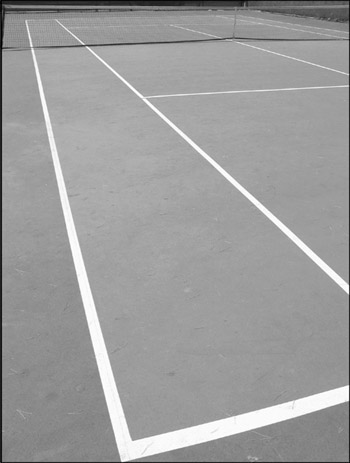Boundaries
|
| < Day Day Up > |
|
Boundaries are what separate the game from everything that is not the game. As discussed in Chapter 2 on page 27, boundaries can be physical-like the edges of an arena, playing field, or game board-or they may be conceptual, such as a social agreement to play. For instance, ten people may be physically sitting in a room where Truth or Dare is being played, but two of them may not have agreed to play and are therefore outside the boundaries of the system.
Why are boundaries an important aspect of game design? Think about what might happen if there were no boundaries in a familiar game system. Imagine a game like football. What if you tried to play football (either in a physical setting or on a computer) without boundaries? Players could run anywhere they wanted to; they could run as far as they could physically get without being tackled by the other team or blocked by random objects like buildings or cars.
What does this do to the strategy of football? What about the abilities necessary for play? Apply this line of thinking to other games you know. Can you see how they would be intrinsically different if their boundaries were not closed? What if you could add real money to the bank in Monopoly? Or if you could add cards to the deck in poker? What if the edges of a chess board were infinitely expanding? It's clear without even playing these that without their boundaries they'd become totally different games.
In addition to the purely practical reason for game boundaries, there's also an emotional one. The boundaries of the game serve as a way to separate everything that goes on in the game from daily life. So, while you may act the part of a cutthroat opponent facing off against your best friend within the boundaries of a game (taking over their civilization or destroying their forces), you can shake hands at the end of the game and walk away without any real damage to your relationship. In fact, you may feel closer to them, having met in this game-world competition.
The play theorist Johan Huizinga calls the abstract space that the boundaries of games create the 'magic circle,' a temporary world where the rules of the game apply, rather than the rules of the ordinary world.[4]
Are there games that do not have exact boundaries? Some games are very 'free form' and do not require strictly defined boundaries to work. An example of this is tag. Tag is usually played with loosely defined boundaries with no detriment to the overall experience. Some modern game designers have also realized that interaction with outside elements might be an interesting design choice for their systems. An example of a more complex game system that has this type of interaction with the environment outside the game system proper is Magic: The Gathering.
In Magic, players purchase an initial deck with enough cards to get started, but this is only the surface of the system. To create better decks, players can buy or trade other cards to add to their collection. As time goes on, Wizards of the Coast, the publisher of the game, adds new cards to the system and withdraws old ones. This ever-changing universe of cards within the system creates a game with expansive boundaries, although at any given time, there are actually limits to the universe of cards.
The way that Magic treats the boundaries of its system is something of an exception. Most games are 'closed' systems. These games clearly define that which is within the game versus that which is outside the game, and purposefully keep the in- game elements from interacting with outside forces. It is up to you as the game designer to determine just where and how these boundaries are defined, and when or if to ever breach them.

Figure 3.35: Boundaries of a tennis court
Exercise 3.11: Boundaries
What are the boundaries in the game Dungeons & Dragons? Can you think of physical and conceptual boundaries?
[4]Johan Huizinga, Homo Ludens: A Study of the Play Element in Culture (Boston: The Beacon Press, 1971), p. 10.
|
| < Day Day Up > |
|
EAN: 2147483647
Pages: 162